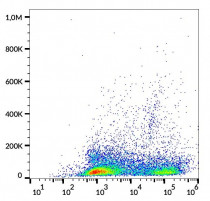ARG63071
anti-MHC Class II antibody [M5/114] (FITC)
anti-MHC Class II antibody [M5/114] (FITC) for Flow cytometry and Mouse
Immune System antibody
Overview
| Product Description | FITC-conjugated Rat Monoclonal antibody [M5/114] recognizes MHC Class II |
|---|---|
| Tested Reactivity | Ms |
| Tested Application | FACS |
| Specificity | The clone M5/114 reacts with murine MHC class II glycoproteins. It recognizes a shared determinant on I-Ab, I-Ad, I-Aq, and I-Ed, I-Ek alloantigens, but it does not react with I-Af, I-Ak, I-As. This antibody can inhibit I-A-restricted T cell responses of the H-2b, H-2d, H-2q, H-2u but not H-2f, H-2k, H-2s haplotypes. |
| Host | Rat |
| Clonality | Monoclonal |
| Clone | M5/114 |
| Isotype | IgG2b |
| Target Name | MHC Class II |
| Antigen Species | Mouse |
| Immunogen | Activated C57BL/6 mouse spleen cells. |
| Conjugation | FITC |
| Alternate Names | HLA-DRB; HLA class II histocompatibility antigen, DRB1-3 chain; SS1; MHC class II antigen DRB1*3; HLA-DR1B; DRw10; Clone P2-beta-3; DRB1 |
Application Instructions
| Application Suggestion |
|
||||
|---|---|---|---|---|---|
| Application Note | * The dilutions indicate recommended starting dilutions and the optimal dilutions or concentrations should be determined by the scientist. |
Properties
| Form | Liquid |
|---|---|
| Purification Note | The purified antibody is conjugated with Fluorescein isothiocyanate (FITC) under optimum conditions. The reagent is free of unconjugated FITC. |
| Buffer | PBS (pH 7.4) and 15 mM Sodium azide |
| Preservative | 15 mM Sodium azide |
| Concentration | 0.5 mg/ml |
| Storage Instruction | Aliquot and store in the dark at 2-8°C. Keep protected from prolonged exposure to light. Avoid repeated freeze/thaw cycles. Suggest spin the vial prior to opening. The antibody solution should be gently mixed before use. |
| Note | For laboratory research only, not for drug, diagnostic or other use. |
Bioinformation
| Gene Symbol | H2-D1 |
|---|---|
| Gene Full Name | histocompatibility 2, D region locus 1 |
| Background | MHC (major histocompatibility complex) class II molecules are transmembrane glycoproteins expressed on the surface of professional antigen-presenting cells, such as macrophages, dendritic cells and B cells. Before their exposition on the cell surface, the MHC class II molecules react with endocytosed exogenous antigens, which are then presented to the T cells. The antigen-binding grove between MHC class II alpha and beta chain is open at both ends and is 15-24 amino acid residues long. |
| Function | Involved in the presentation of foreign antigens to the immune system. [UniProt] |
| Research Area | Immune System antibody |
| Calculated MW | 30 kDa |
| PTM | Ubiquitinated by MARCH1 and MARCH8 at Lys-254 leading to sorting into the endosome system and down-regulation of MHC class II. |
Images (1) Click the Picture to Zoom In






